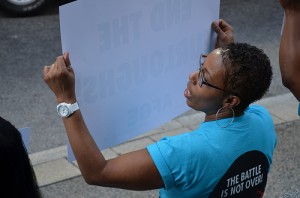What's your new "Situation Normal"?
07 March 2014 – Sam Tamburro

US federal government workers at an August 2013 protest of budget sequestration and employee furloughs. Photo credit: American Federation of Government Employees
As I sit down to write this post (and by the way, this is my first “official” history blog post), I am pondering what my “New Situation Normal” is as a public history practitioner for a federal agency. How has my work reality changed, for good and for ill, over the past 16 years? Certainly, technology and social media provide public historians with avenues to new and varied audiences. And with the Internet’s narrowing of time and space, interesting and exciting possibilities now exist for researchers and public historians.
However, there have been less positive workplace changes, namely budgetary and staffing constraints, which have created stresses and reprioritization at work for many American public historians in the public and private sector—as well as in other countries—regardless of agency or organization. Changes for me have been restrained travel and increased use of teleconferences and online training to stay professionally current and to focus my time and our limited budget on “mission critical” duties of the National Park Service. One consequence is limited participation in professional conferences, which makes it increasingly challenging to stay connected and engaged with my public history colleagues. As a result, I won’t be attending the upcoming Annual Meeting of the National Council on Public History in Monterey, but I will be participating virtually through this blog and teleconferences. This is my attempt to keep a “foot in the field” and adapt to an ever-changing work reality. But, I acknowledge that there are limitations to this approach.
Another reality is that I have fewer colleagues in my agency “doing” history. An increase in the number of retirements and our inability to fully staff positions have become grudgingly accepted realities—a new situation normal. These realities are eloquently articulated and documented in the recently published report from the Organization of American Historians titled Imperiled Promise: The State of History in the National Park Service. Now, even though we may not be able to completely alter the down-trending or flat budgetary course, we can effectively control how to adapt and respond to it. So I ask, “What’s your new Situation Normal, and how have you committed to stay resilient and relevant?” This question and your responses are the focus of our session at the upcoming Annual Meeting of the National Council on Public History in Monterey titled, “Situation Normal? Ways Past Sequestrations, Shutdowns, and Budgetary Woes.” Our conversation will take place Thursday, March 20 from 3:30 to 5 p.m.
This session invites public historians to speak openly about working in and with federal agencies when extreme budgetary constraints make professional travel, seasonal hiring, internships, contract work, new projects, and other activities difficult-to-impossible to arrange. Our conversation will go wide as well, highlighting advocacy efforts to rouse public and private support for history funding. I think it is important to note that we do not intend this structured conversation to simply be an “airing of the grievances” but hope to leave Monterey with thoughtful approaches and strategies to the funding and relevancy challenges we face as public historians and share them with our colleagues.
We have recruited panelists from many different aspects of the public history profession to stimulate a broad discussion of the issues and possible solutions. Lee White, Executive Director of the National Coalition for History, will discuss the outlook from Capitol Hill and across key federal agencies. Max van Balgooy, President of Engaging Places, LLC, will provide a national perspective on the economic condition of history organizations, particularly historic sites operated by non-profit organizations, as well as a new grassroots effort to raise the profile of history in the general public. Our facilitator will be Angela Sirna, a PhD Candidate in Public History at Middle Tennessee State University who is studying the history of the National Park Service.
We are encouraging participants to tweet the session using the hashtag #newnorm. If you are unable to attend the conference, like myself, please follow along on Twitter. We look forward to seeing and hearing from you in Monterey!
~ Sam Tamburro is a historian in the Intermountain Region Office of the National Park Service in Santa Fe, New Mexico.




Sam, Sorry that you won’t be there, but I’m looking forward to the discussion.